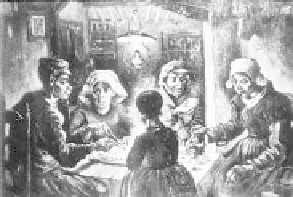Travel Reference
In-Depth Information
The Potato Eaters
(1885)
“Those that prefer to see the peasants in their Sunday-best may
do as they like. I personally am convinced I get better results by
painting them in their roughness.... If a peasant picture smells
of bacon, smoke, potato steam—all right, that's healthy.”
—Vincent van Gogh
In a dark, cramped room lit only by a dim lamp, poor workers
help themselves to a steaming plate of potatoes. They've earned it.
Vincent deliberately wanted the canvas to be potato-colored.
Vincent had dabbled as an artist during his wandering years,
sketching things around him and taking a few art classes, but it
wasn't until age 29 that he painted his first oil canvas. He soon
threw himself into it with abandon.
He painted the poor working peasants. He worked as a lay
minister among the poorest of
the poor, peasants and miners.
He joined them at work in the
mines, taught their children, and
even gave away his own few pos-
sessions to help them. The church
authorities finally dismissed him
for “excessive zeal,” but he came
away understanding the poor's
harsh existence and the dignity with which they bore it.
Still Life with Bible
(1885)
“I have a terrible need of—shall I say the word?—religion.
Then I go out and paint the stars.”
—Vincent van Gogh
The Bible and Emile Zola's
La
Joie de Vivre
—these t wo books
dominated Van Gogh's life. In
his art, he tried to fuse his reli-
gious upbringing with his love
of the world 's beauty. He lusted
after life with a religious fervor.
The burned-out candle tells us of
the recent death of his father. The
Bible is open to Isaiah 53: “He was despised and rejected of men, a
man of sorrows....”
The Old Church Tower at Nuenen
(1885)
The crows circle above the local cemetery of Nuenen. Soon after
his father's death, Vincent—in poor health and depressed—
moved briefly to Antwerp. He then decided to visit his brother
Theo, an art dealer living in Paris, the art capital of the world.






















